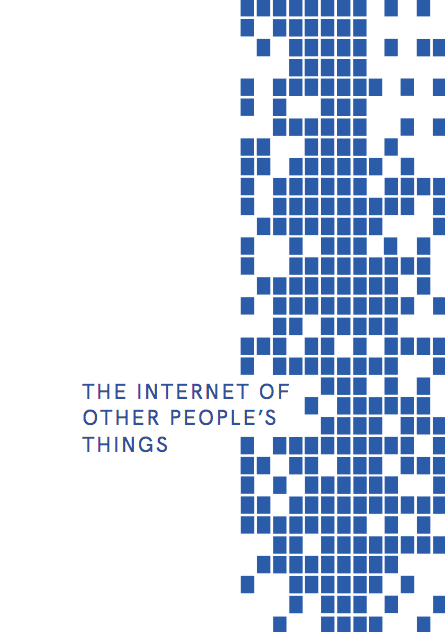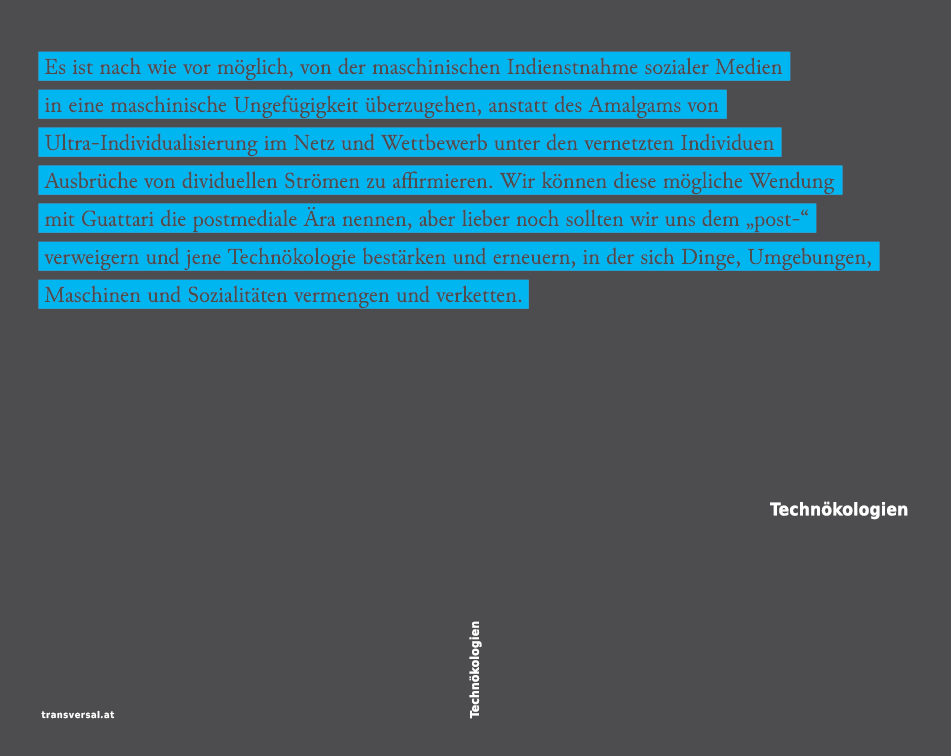Linda Kronman, Andreas Zingerle (eds.): The Internet of Other People’s Things (2018)
Filed under book | Tags: · city, data, governance, infrastructure, internet of things, urbanism

“The Internet of Things (IoT), smart city initiatives, and smart home technology are marketed to us as sleek and glamorous 3D renderings promising a convenient and sustainable technology that will save us and our planet from a future of environmental distress. Yet the buzzword bingo of smart city rhetoric, the polished advertisements for networked devices, and the glossy packaging of smart home devices are in stark contrast to the news and research which investigates the vulnerabilities of our connected lives. The expansion of the IoT and the proliferation of virtually-connected data points are providing ever increasing amounts of information for those keen on use or abuse. The massive implementation of IoT in hyper-connected urban environments, paths the way to technocratic governance and urban development, corporatizing our living spaces into lock-in, hack-able, “pan optic” smart cities. The IoT seems to develop towards an Internet of Other People’s Things (IoOPT), where users do not own their data, agree to Terms of services that mean their data are then shared by default to third parties, and the risks that citizens rights are managed by technocratic governance or cyber criminals attacking critical infrastructures are always present.
In this cyberwar of ideas, an asymmetric battle for power and influence, systems will have to be more robust and people will have to be more vigilant. Therefore we turned to the community of artists, designers, activists, hackers and researchers with an open call for new critical perspectives on ubiquitous technology and its impact on our lifestyle. We were looking for projects that abuse to expose; artistic research and tacit knowledge that is produced through cultures of making, hacking, and reverse engineering. Our aim was to collect artworks, projects, essays, and interviews discussing questions such as: What does privacy look like in a smart home of connected objects? How are citizens involved in co-design collaborations with private corporations and the public sector to build better cities? How can we enable a secure and trustworthy Internet communication so that business, personal, and machine-to-machine interactions can be conducted safely and without interference?”
Publisher servus.at, Linz, 2018
Creative Commons BY-SA 4.0 International License
ISBN 9783950420012
235 pages
Christoph Brunner, Raimund Minichbauer, Kelly Mulvaney, Gerald Raunig (eds.): Technökologien (2018) [German]
Filed under book | Tags: · ecology, environment, media, media archeology, social movements, technology, technopolitics

“Im dividuell-maschinischen Kapitalismus geht Technologie weit über die dichotomen Figuren von Techno-Euphorie (maschinischer Fortschritt in der Hand von Menschen) und Techno-Phobie (Menschen als Instrumente der Maschinen) hinaus. In so unterschiedlichen Feldern wie finanziellen Derivaten und Kryptowährungen, digitalen Schnitten und Data Doubles, biometrischen Filmbildern und sozialen Medien werden Technologien zu Umwelt, Umhüllung, Umgebung.
Mit dem Begriffsvorschlag Technökologien und Beispielen aus der Medienarchäologie der 1990er und 2000er Jahre, vor allem aber anhand der Untersuchung konkreter aktueller Praxen versucht das vorliegende Buch, diesen Verschiebungen gerecht zu werden: In der Mitte der technökologischen Subjektivierung, die nicht selten die Form von Wut, Angst, Hass und Häme annimmt, ergeben sich auch neue Weisen der Affizierung, neue Äußerungsweisen, neue Verhältnissetzungen von Technopolitik und sozialer Bewegung.
Mit Beiträgen von: Christoph Brunner, Marco Deseriis, Katrin M. Kämpf und Christina Rogers, Brigitta Kuster, Stamatia Portanova, Gerald Raunig, Álvaro Ruiz, Raúl Sánchez Cedillo.”
Publisher transversal texts, Vienna, August 2018
Copyleft
ISBN 9783903046214, 3903046213
157 pages
Ravi Sundaram: Pirate Modernity: Delhi’s Media Urbanism (2009)
Filed under book | Tags: · city, delhi, globalisation, infrastructure, mass media, modernism, modernity, piracy, postcolonialism, urban planning, urban studies, urbanism

“Using Delhi’s contemporary history as a site for reflection, Pirate Modernity moves from a detailed discussion of the technocratic design of the city by US planners in the 1950s, to the massive expansions after 1977, culminating in the urban crisis of the 1990s.
As a practice, pirate modernity is an illicit form of urban globalization. Poorer urban populations increasingly inhabit non-legal spheres: unauthorized neighborhoods, squatter camps and bypass legal technological infrastructures (media, electricity). This pirate culture produces a significant enabling resource for subaltern populations unable to enter the legal city. Equally, this is an unstable world, bringing subaltern populations into the harsh glare of permanent technological visibility, and attacks by urban elites, courts and visceral media industries. The book examines contemporary Delhi from some of these sites: the unmaking of the citys modernist planning design, new technological urban networks that bypass states and corporations, and the tragic experience of the road accident terrifyingly enhanced by technological culture. Pirate Modernity moves between past and present, along with debates in Asia, Africa and Latin America on urbanism, media culture, and everyday life.
This pioneering book suggests cities have to be revisited afresh after proliferating media culture. Pirate Modernity boldly draws from urban and cultural theory to open a new agenda for a world after media urbanism.”
Publisher Routledge, Oxford & New York, 2009
Asia’s Transformations series
ISBN 9780415409667, 0415409667
xix+224 pages
HT Geraldine
Reviews: Diya Mehra (SAMAJ, 2011), Fei An Tjan (Masters of Media, 2010).
PDF (10 MB)
Comment (0)
